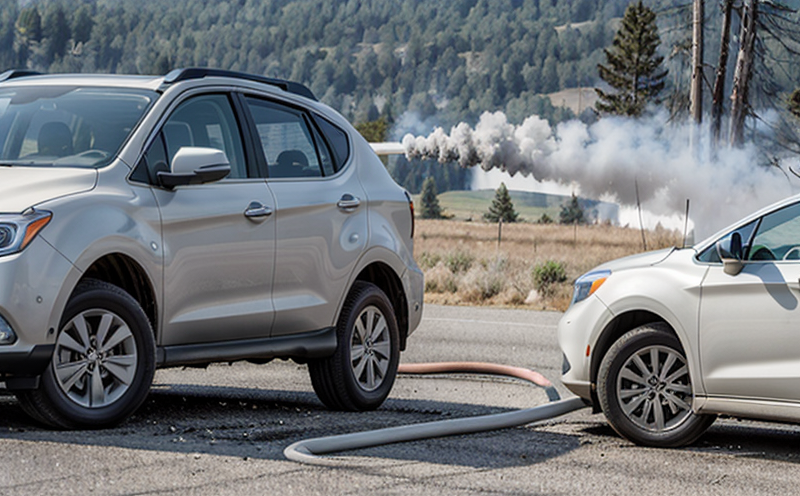NOx Emission Testing During Material Fires
The testing of nitrogen oxides (NOx) emissions during material fires is a critical component in ensuring public safety and compliance with environmental regulations. NOx compounds, primarily NO and NO2, are formed during high-temperature combustion processes and can have significant adverse effects on air quality and human health.
When materials burn, especially in industrial settings or during accidental fires, the formation of NOx is influenced by various factors including fuel type, combustion temperature, oxygen concentration, and flame characteristics. This testing is essential for evaluating the environmental impact and ensuring that materials used in fire situations do not contribute disproportionately to air pollution.
Our comprehensive testing service includes detailed analysis using state-of-the-art equipment such as gas chromatography with pulsed fluorescence detection (GC-PFD) or other relevant technologies, which can accurately measure NOx levels. This allows us to provide precise data that helps our clients make informed decisions about the safety and environmental impact of their products.
The testing process involves several key steps: specimen preparation, ignition in controlled conditions, monitoring of combustion parameters, and subsequent analysis of emitted gases. Specimen preparation ensures that each sample is representative of the material under test, while the controlled environment allows for consistent results across tests.
Our team of experts uses international standards such as ISO 13984-2:2017, which provides guidelines for testing the flammability and fire performance of materials. This ensures that our findings are both reliable and internationally comparable. The acceptance criteria for these tests are stringent, focusing on minimizing NOx emissions to acceptable levels.
Understanding the real-world implications of this testing is crucial. For instance, in the construction sector, understanding how different types of insulation materials behave during a fire can help architects design safer buildings. In the automotive industry, ensuring that seat upholstery does not emit harmful levels of NOx when exposed to flames is vital for both safety and compliance.
The importance of this testing extends beyond mere compliance; it also plays a role in fostering innovation within sectors that rely heavily on combustible materials. By identifying which materials perform best under fire conditions, manufacturers can develop safer products while reducing environmental impact.
Benefits
The benefits of NOx emission testing during material fires are multifaceted and extend across various sectors including construction, automotive manufacturing, and consumer goods. Here’s how this testing contributes to different stakeholders:
- Enhanced Public Safety: Reducing NOx emissions from materials used in fire situations directly improves air quality, thereby protecting public health.
- Compliance with Regulations: Ensures adherence to international standards like ISO 13984-2:2017, which mandates rigorous testing protocols for combustible materials.
- Innovation and Product Development: Encourages the development of safer and more environmentally friendly products by identifying optimal material properties under fire conditions.
- Cost Savings: Early detection of problematic materials through comprehensive testing can save costs associated with product recalls or redesigns after market release.
In summary, NOx emission testing during material fires is not just a compliance requirement but also a proactive step towards enhancing safety and sustainability in various industries.
Industry Applications
| Industry | Applications |
|---|---|
| Automotive Manufacturing | Evaluating upholstery materials for NOx emissions during fires. |
| Construction | Analyzing insulation and other building materials for their fire performance and NOx release. |
| Consumer Goods | Testing packaging and other materials used in consumer products to ensure they do not emit harmful levels of NOx during fires. |
| Aerospace | Evaluating interior furnishings for aircraft to prevent toxic gas emissions.
| Industry | Applications |
|---|---|
| Military | Testing combat vehicle interiors and textiles used in fire safety applications. |
| Biofuel Production | Evaluating biofuels for their combustion characteristics and NOx emissions. |
| Medical Equipment Manufacturing | Ensuring materials used in patient care areas do not release harmful gases during fires. |
Environmental and Sustainability Contributions
NOx emission testing plays a pivotal role in promoting environmental sustainability by identifying materials that contribute less to air pollution during fires. By minimizing NOx emissions, this testing supports efforts to improve air quality and reduce the overall carbon footprint of industries.
In addition to immediate health benefits, reducing NOx emissions also contributes to long-term environmental goals set forth by international bodies such as the United Nations Framework Convention on Climate Change (UNFCCC). Compliance with these standards can lead to better regulatory alignment and increased global cooperation in addressing climate change.
Furthermore, sustainable practices like this testing encourage circular economy principles by promoting the use of recycled materials that meet stringent emission criteria. This approach not only reduces waste but also supports economic growth through innovation and resource efficiency.





